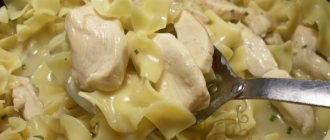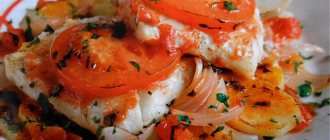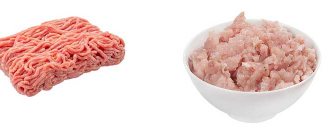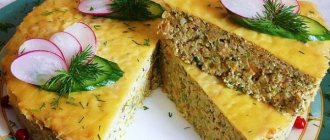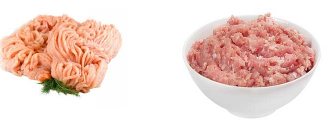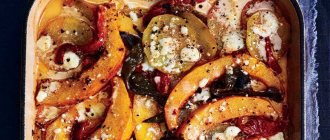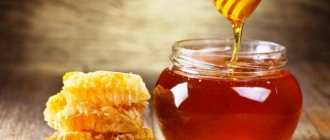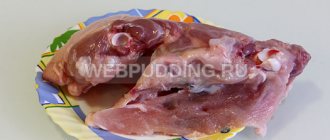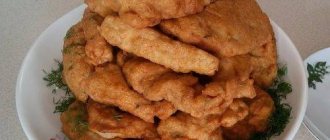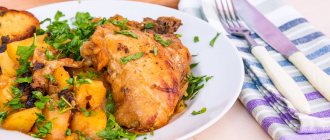Chicken breast for losing weight
Chicken is a universal dietary product. Health nutritionists have long given this verdict to this meat. And it's not just about how many calories are in chicken breast.
This dish has excellent taste, has a minimum of fat and many useful elements. This will not only allow you to lose unnecessary pounds without experiencing a painful feeling of hunger, but also improve your body’s health.
The basis of chicken meat is protein. Its amount is 84% - it is a building material for cells. At the same time, white meat contains a minimum fat reserve - 15%, and carbohydrates in it no more than 1%. So this is an ideal choice for those who want to get slim. But how many calories will a chicken fillet dish give you?
Calorie content of chicken breasts and their benefits
Since the range of caloric content of fillet is low, and it is unlikely that lovers of tasty food will be stopped by the extra 23 kcal, they will probably be interested in knowing which dish will be healthier when prepared. For example, the calorie content of a chicken breast baked in the oven will be the same as grilled - the highest. But the first cooking method is more beneficial for the body, especially if the chicken is baked in the sleeve, that is, in its own juice. There is no point in removing the crust with this cooking method: the meat will be dry and tough. And, of course, boiled, stewed meat without skin is the most easily digestible and healthy. You can eat it not only while on a diet, but also during many illnesses, when you don’t feel like eating, but the body needs strength.
How many calories are in baked chicken breast?
To prevent baked chicken breast from being dry, it is best to bake it in a special sauce.
Do you want to lose weight? Then these articles are for you
For the sauce we need: 1 tbsp. olive oil, 1 tbsp. soy sauce, your favorite seasonings and the secret ingredient - mustard. Mustard will make the breast much juicier.
Mix the ingredients for the sauce and coat the chicken breast with it. Let it marinate for 10-15 minutes.
Place the marinated breast in foil and place in the oven for 10 - 15 minutes.
This baked chicken breast contains 148 kilocalories.
To summarize, we can say that the most dietary option for preparing chicken breast is boiling or preparing broth.
In these cases, the breast will contain the least amount of calories.
Chicken breast (in other words, white chicken meat) is a wonderful product, tasty and healthy.
Boiled chicken breast is truly a dietary product. Boiled white meat is used in preparing all kinds of salads, stews, vegetable soups, pates, and minced meats. Thanks to its composition, boiled chicken breast is suitable for people of any age - both small children and the elderly. Due to the presence of vitamins and other beneficial substances in it, it is well suited for athletes and those on a diet.
How many calories are in boiled skinless chicken breast:
If boiled white chicken meat does not have skin, its calorie content will decrease.
The calorie content of boiled skinless chicken breast is 110 kcal per 100 g. product
How many calories are in baked chicken breast:
There is a simple way to prepare white chicken meat - bake a chicken breast.
Calorie content of baked chicken breast is 137 kcal per 100 g. product
How many calories are in chicken breast baked with cheese:
The taste of white chicken meat can be perfectly combined with the taste of cheese. A wonderful dish - chicken breast baked with cheese - will delight you not only with its taste, but also with its relatively low calorie content.
Calorie content of chicken breast baked with cheese – 119 kcal per 100 g. product
Chicken breast calories
Depending on the method of heat treatment, the use of seasonings and the characteristics of the poultry carcass, the calorie content of the breasts differs. Let's look at the average indicators.
Fried
Whether purchased or raised at home, the breast is initially on the bone and covered with skin. Many people love the taste of the latter, especially when the meat is grilled and fried in vegetable oil and a fragrant and crispy “crust” is formed. But in addition to its pleasant taste, chicken skin is distinguished by its calorie content and the presence of not the most useful elements in its composition, so many nutritionists do not recommend it for consumption.
On average, fried chicken breast has almost 150 calories per 100 grams of cooked weight.
Boiled
Boiled chicken skin is not as dangerous as fried chicken skin, but it does affect the calorie content of the product. Thus, pure chicken meat cooked at normal times until soft and fibers disintegrate has an energy value of 95-100 calories per 100 grams of product.
The same meat, covered with skin, will carry 130 calories in every hundred-gram piece.
With steamed vegetables
Chicken breast with steamed vegetables is the most popular healthy and low-calorie lunch or dinner option for any age. This is a very good combination, because the fiber from plant foods helps proteins to be better absorbed.
The calorie content of the dish will be determined by the selected vegetables and their ratio to meat. If you take green vegetables such as asparagus, broccoli, zucchini and zucchini and they make up half the serving, then in every 100 grams of this mixture there will be approximately 96-100 calories.
Baked in the oven
Breast baked in the oven is a great alternative to the usual legs and sausages. The dish is easy to prepare and has a pleasant taste. This type of breast is considered a figure-safe product. Its calorie content is approximately 150 calories with moderate use of seasonings.
Baked with cheese
The energy value of such a tasty and at the same time dietary dish as chicken breast baked with cheese depends on what type of cheese is chosen. The higher the percentage of fat content, the higher the calorie content of the product.
- Low-fat cheese or similar cheeses - 100 grams of breast underneath - up to 150 calories;
- medium-fat cheese, including soft cheeses such as mozzarella and Adyghe - up to 170 calories;
- hard fatty cheese: Dutch, Russian, Parmesan and others - about 190-200 calories.
On average, per 100 grams of raw meat, take up to 10 grams of hard cheese.
Need to know. It's no secret that the mass of a raw product differs from the finished one. This can be confusing when counting calories. Meat is characterized by greater weight and volume in its raw form. We served these ready-made dishes; you can cut pieces from them and adjust the portion sizes in accordance with the KBJU.
What is included in chicken meat>
- B3 (niacin) is involved in metabolic reactions, promotes the production of energy from carbohydrates, fats and proteins, and is part of cellular enzymes involved in respiration and metabolism.
- B4 (choline) is involved in the synthesis of acetylcholine, which transmits nerve impulses, regulates insulin levels, promotes the normal functioning of the liver, kidneys and hematopoietic organs.
- B6 (pyridoxine) is involved in the metabolism of proteins and fats. Contributes to the production of red blood cells that distribute oxygen. Necessary for the conversion of glycogen into glucose, for the normal functioning of the immune system and for the formation of nerve cells.
- B9 (folic acid) is essential for the functioning of the circulatory and immune systems.
White chicken meat contains vitamins A, C, H. Chicken breasts are an excellent source of selenium and phosphorus. They contain potassium, magnesium, sulfur, chromium, copper, fluorine, zinc. True, chicken meat is significantly inferior in iron content to beef and pork (1.5 mg versus 3 mg per 100 g of product).
Recipe Chicken baked in the oven. Calorie, chemical composition and nutritional value.
Nutritional value and chemical composition of “Chicken baked in the oven.”
The table shows the nutritional content (calories, proteins, fats, carbohydrates, vitamins and minerals) per 100 grams of edible portion.
| Nutrient | Quantity | Norm** | % of the norm in 100 g | % of the norm in 100 kcal | 100% normal |
| Calorie content | 188 kcal | 1684 kcal | 11.2% | 6% | 896 g |
| Squirrels | 19.6 g | 76 g | 25.8% | 13.7% | 388 g |
| Fats | 9.9 g | 56 g | 17.7% | 9.4% | 566 g |
| Carbohydrates | 5.2 g | 219 g | 2.4% | 1.3% | 4212 g |
| Alimentary fiber | 1.3 g | 20 g | 6.5% | 3.5% | 1538 g |
| Water | 55.8 g | 2273 g | 2.5% | 1.3% | 4073 g |
| Ash | 0.064 g | ~ | |||
| Vitamins | |||||
| Vitamin A, RE | 33.1 mcg | 900 mcg | 3.7% | 2% | 2719 g |
| beta carotene | 0.069 mg | 5 mg | 1.4% | 0.7% | 7246 g |
| Vitamin B1, thiamine | 0.079 mg | 1.5 mg | 5.3% | 2.8% | 1899 |
| Vitamin B2, riboflavin | 0.137 mg | 1.8 mg | 7.6% | 4% | 1314 g |
| Vitamin B4, choline | 67.62 mg | 500 mg | 13.5% | 7.2% | 739 g |
| Vitamin B5, pantothenic | 0.755 mg | 5 mg | 15.1% | 8% | 662 g |
| Vitamin B6, pyridoxine | 0.514 mg | 2 mg | 25.7% | 13.7% | 389 g |
| Vitamin B9, folates | 7.338 mcg | 400 mcg | 1.8% | 1% | 5451 g |
| Vitamin B12, cobalamin | 0.515 mcg | 3 mcg | 17.2% | 9.1% | 583 g |
| Vitamin C, ascorbic acid | 4.58 mg | 90 mg | 5.1% | 2.7% | 1965 |
| Vitamin E, alpha tocopherol, TE | 0.727 mg | 15 mg | 4.8% | 2.6% | 2063 g |
| Vitamin H, biotin | 8.756 mcg | 50 mcg | 17.5% | 9.3% | 571 g |
| Vitamin K, phylloquinone | 5.2 mcg | 120 mcg | 4.3% | 2.3% | 2308 g |
| Vitamin RR, NE | 11.8023 mg | 20 mg | 59% | 31.4% | 169 g |
| Niacin | 0.051 mg | ~ | |||
| Macronutrients | |||||
| Potassium, K | 286.6 mg | 2500 mg | 11.5% | 6.1% | 872 g |
| Calcium, Ca | 43.52 mg | 1000 mg | 4.4% | 2.3% | 2298 g |
| Silicon, Si | 0.109 mg | 30 mg | 0.4% | 0.2% | 27523 g |
| Magnesium, Mg | 27.07 mg | 400 mg | 6.8% | 3.6% | 1478 g |
| Sodium, Na | 556.47 mg | 1300 mg | 42.8% | 22.8% | 234 g |
| Sera, S | 175.11 mg | 1000 mg | 17.5% | 9.3% | 571 g |
| Phosphorus, Ph | 185.6 mg | 800 mg | 23.2% | 12.3% | 431 g |
| Chlorine, Cl | 73.26 mg | 2300 mg | 3.2% | 1.7% | 3140 g |
| Microelements | |||||
| Aluminium, Al | 19.3 mcg | ~ | |||
| Bor, B | 40.9 mcg | ~ | |||
| Vanadium, V | 0.17 mcg | ~ | |||
| Iron, Fe | 2.152 mg | 18 mg | 12% | 6.4% | 836 g |
| Yod, I | 6.42 mcg | 150 mcg | 4.3% | 2.3% | 2336 g |
| Cobalt, Co | 11.962 mcg | 10 mcg | 119.6% | 63.6% | 84 g |
| Lithium, Li | 0.128 mcg | ~ | |||
| Manganese, Mn | 0.274 mg | 2 mg | 13.7% | 7.3% | 730 g |
| Copper, Cu | 103.37 mcg | 1000 mcg | 10.3% | 5.5% | 967 g |
| Molybdenum, Mo | 1.08 mcg | 70 mcg | 1.5% | 0.8% | 6481 g |
| Nickel, Ni | 0.723 mcg | ~ | |||
| Rubidium, Rb | 2.7 mcg | ~ | |||
| Selenium, Se | 1.308 mcg | 55 mcg | 2.4% | 1.3% | 4205 g |
| Fluorine, F | 117.98 mcg | 4000 mcg | 2.9% | 1.5% | 3390 g |
| Chromium, Cr | 9.81 mcg | 50 mcg | 19.6% | 10.4% | 510 g |
| Zinc, Zn | 2.0653 mg | 12 mg | 17.2% | 9.1% | 581 g |
| Digestible carbohydrates | |||||
| Starch and dextrins | 1.106 g | ~ | |||
| Mono- and disaccharides (sugars) | 0.2 g | max 100 g | |||
| Sterols (sterols) | |||||
| Cholesterol | 34.36 mg | max 300 mg |
The energy value of chicken baked in the oven is 188 kcal.
- Serving = 200 g (376 kcal)
Primary Source: Created in the application by the user. Read more.
** This table shows the average levels of vitamins and minerals for an adult. If you want to know the norms taking into account your gender, age and other factors, then use the “My Healthy Diet” application.
The benefits of chicken fillet
Chicken breast is not only a valuable source of protein for our body, but also contains many different vitamins and minerals. Vitamins, in turn, take an active part in the processes of protein synthesis and other substances. Vitamins are essential for strength training; without them, it is impossible to effectively lose weight or increase muscle mass, regardless of the amount of protein consumed.
Chicken breast contains vitamins B, C, PP, A, as well as choline, a substance that ensures the proper functioning of organs, in particular the kidneys and adrenal glands, and cleanses the liver of excess fats and cholesterol. Potassium, which is contained in chicken fillet, acts as electrolytes in the body and helps maintain normal blood pressure. Chicken breast also contains equally important micro- and macroelements: sodium, magnesium, sulfur, iron, phosphorus and chlorine.
The nutritional value of chicken breast is great. This is a quite nutritious and healthy product, but the calorie content of chicken breast is balanced. 100 grams of fillet contain the most protein - 23.6 grams, there is little fat - 1.9 grams, and very few carbohydrates - up to 0.4 grams.
Boiled chicken breast is very useful for problems with the gastrointestinal tract, including gastritis and ulcers, it promotes digestion and neutralizes excess acidity in the body. White chicken meat is also useful for problems with blood vessels, it helps prevent heart attacks and strokes, and
The low calorie content of boiled chicken breast helps not to overload the body with extra calories. It is best to boil chicken in a saucepan, but the healthiest option is steamed chicken, which retains all the nutrients, has a beautiful appearance, and becomes very juicy and soft. Chicken breast is best consumed with vegetables to balance the simultaneous intake of protein and fiber in the body.
Chicken fillet is good for teeth, bone tissue and muscles; it contains the largest amount of zinc and phosphorus. Magnesium improves memory, restores nerve cells, relieves irritability, promotes wound healing, and B vitamins normalize blood sugar levels, which is why chicken breast is also recommended for elderly people.
Eating chicken breast has a positive effect on the body's metabolic processes, improves skin color, condition of nails and hair, and the selenium and lysine it contains have good antibacterial properties and strengthen the immune system, preventing colds.
How many calories are in chicken breast
In addition to proteins, chicken breast contains vitamins and minerals, as well as micro- and macroelements necessary for the body:
- B vitamins - normalize blood sugar levels;
- choline is a substance that promotes normal functioning of the kidneys and adrenal glands, cleansing the liver of harmful fats and cholesterol;
- potassium - maintains normal blood pressure;
- zinc and phosphorus - strengthen teeth, bone and muscle tissue;
- magnesium - improves memory, relieves irritability;
- selenium, lysine - strengthen the immune system.
Or rather, from her breast without compromising her figure? The minimum amount of calories is in boiled chicken fillet - 110 kcal per 100 g. Breast boiled with bones - 137 kcal, and with skin - 164 kcal. Thus, the largest amount of fat is contained in the skin. Braised skinless breast is also low in calories (125 kcal per 100 g).
A breast baked over a fire or in the oven in the “grill” mode contains 160 kcal. When frying in sunflower oil, the calorie content of the product increases to 200 kcal per 100 g. Smoked breast has almost the same calorie content (185 kcal).
Diets with chicken breast
Thanks to its balanced composition, chicken breast is an excellent diet product. So experts in the field of weight loss have developed several types of diets based on chicken breast. The first of them is seven days. For it you need to boil 800 g of chicken meat in 2 liters of water. In order to preserve the taste of the product, you can add celery root, carrots and onions to the pan to taste. Then divide the boiled chicken meat into 5-6 equal portions in proportion to meals per day. The main feature of the diet is the non-use of salt when preparing dishes. It is also prohibited to add soy sauce to enhance the taste. You can use lemon juice to add some piquancy. The disadvantage of this diet is that it cannot be used for people with kidney, liver, heart and stomach diseases. In addition, it is also contraindicated for pregnant women.
There is a second diet option using chicken meat. It is designed for the same 6-7 days. In the first three days, you are allowed to eat only apples (1.5-2 kg per day in equal shares). Then 1 day - 1 kg of chicken breast, the next 2 days - 2 liters of kefir (1%) per day. Last day - chicken broth, prepared without salt.
On average, following one of the diets you can lose from 1.5 to 3 kg, which is not a bad result. Plus, chicken breasts are so nutritious that you won't feel hungry.
Delicious low calorie dishes
Preparing dietary chicken dishes does not take much time, it is convenient and budget-friendly. Several low-calorie recipes should be in the arsenal of any housewife. Cooking deliciously and beautifully serving a dietary dish is a skill worth its weight in gold.
Chicken noodle soup
As a first dish, you can prepare chicken and noodle soup. The energy value of such a soup does not exceed 80 kcal per hundred grams. According to the recipe, to prepare it you will need the following products:
- chicken fillet - 0.5 kg;
- noodles - 200 g;
- chicken egg - 2 pcs.;
- onion - 2 pcs.;
- potatoes - 2 pcs.;
- salt, pepper, herbs, bay leaf - to taste.
Cooking steps:
- Place a pan of water on the fire and place chopped onions, carrots and chicken fillet into it.
- After the water boils, reduce the heat and add the diced potatoes to the pan and add the bay leaf.
- Cover with a lid and cook for twenty minutes.
- After this, add noodles and spices. Crack a couple of eggs directly into the soup and stir thoroughly with a spoon.
- Cook until the noodles and potatoes are soft. If desired, add fresh herbs to the finished soup.
How to properly cook chicken breast
Lean white meat should not be overcooked, otherwise it will turn into dry and tasteless rubber. Breasts should be thawed (retail chains offer customers fresh-frozen or chilled meat), freed from skin and excess fat and placed in boiling water. The water should completely cover the chicken meat. To preserve more valuable vitamins and microelements in the meat, cook it over low heat, along with aromatic seasonings:
The chicken is not covered with a lid during cooking. Aromatic roots and spices are added to the water. This can be onions, carrots, parsley and celery (root or stems), leeks, thyme, rosemary, garlic, basil, cloves, peppercorns, bay leaves, etc. Salt is added at the end of cooking.
White chicken meat is used to make dietary broth and low-calorie vegetable soups, rich in vitamins and minerals. The calorie content of broth made from lean white meat chicken is about 20 kilocalories per 100 grams of product:
1. Pour cold water over the chicken breast.
2.Add:
- one large onion;
- 2 carrots;
- celery stalks;
- a few sprigs of fresh parsley or cilantro;
- salt and pepper to taste;
- 6 cardamom grains;
- Bay leaf.
3. Bring to a boil, reduce heat, and simmer for 40 minutes.
4. Remove the breast from the broth. Strain the broth, cool and place in the refrigerator. Then remove the top layer of fat.
5. If desired, the finished broth can be poured into containers and placed in the freezer.
Chicken breast can be called the most valuable part of a chicken carcass. It has a rich beneficial composition, due to which it is highly valued and recommended for use by all groups of people.
Although some adherents of a vegetarian diet claim that our bodies do not need meat and that the necessary protein can be obtained from plant foods, many studies suggest the opposite. Plant proteins have a different composition from animal protein. Therefore, plant foods are not a complete substitute for animal products. A good option for those who want to eat healthy and eat less fatty foods is chicken breast.
How many kcal are in chicken breast?
The calorie content of chicken breast is relatively low and is about 113 kcal per 100 g of raw product. If we take the daily caloric content recommended for diets as a basis, then a serving of chicken breast will be only 5.6% of the total calories. This calorie content, along with its beneficial composition, attracts the attention of many nutritionists. The view has changed significantly recently, and chicken breast has become a frequent guest on dietary tables. Its use in reasonable doses during diets helps to avoid protein starvation and saturate the body with important vitamins and minerals.
Most of the calories in chicken breast come from protein. Proteins provide about 84% of total calories.
Calorie content of boiled chicken breast
Due to its low calorie content, minimal fat content and healthy composition, chicken breast belongs to the group of dietary products. However, during heat treatment, the calorie content of chicken meat increases. In addition, to improve the taste, seasonings and other ingredients are added to white chicken meat, which significantly increase its calorie content.
If chicken meat is to be consumed as a dietary product, then the best method of preparation would be to boil it. Boiled breast goes well with vegetables and has a calorie content of about 137 units.
Calories in baked chicken breast
Baking chicken breast helps preserve all the nutrients it is rich in. It is best to bake meat in foil, then you will not need to add additional fats. If no seasonings are added to the dish, the calorie content of the breast will remain the same - 113 kcal. However, seasonings, salt, garlic, oil and other ingredients are often added during baking. Additional ingredients increase the calorie content of the finished product to 150 kcal.
Calories in smoked chicken breast
High quality smoked breast should not contain any ingredients other than salt. Adding seasonings may be a sign that the ingredients were not fresh. The use of liquid smoke creates a smoky taste, but does not allow obtaining a high-quality product.
High-quality smoked chicken breast is a conditionally dietary product, as it contains about 184 kcal per 100 g of product.
Calories in Braised Chicken Breast
Stewed chicken breast is made using water, vegetables and seasonings. Since the additional components are much lower than the calorie content of chicken meat, the result is a dish with a reduced calorie content. 100 g of stewed chicken breast contains about 93 kcal. No additional fats are added. Chicken breast pieces should be simmered in a small amount of water.
Supporters of dietary and healthy eating try to include boiled meat in their daily diet. Low-fat varieties, such as poultry, are suitable for this. White poultry meat has always been considered dietary. It was usually used to prepare dishes for children, the elderly and the sick.
This part of the bird was considered the most beneficial for the body for many reasons. What is the calorie content of boiled chicken breast and why is it most often included in the diet menu?
How to properly bake chicken breast?
Chicken breast baked in the oven has virtually no allergic contraindications, and isolated exceptions are so rare that they do not affect the overall picture. The diet can be contraindicated only in cases of absolute rejection of animal products by the body.
For weight loss goals, you can choose any of the many developed diets or simply replace other types of meat with breast. Recipes for preparing pilaf and chops, goulash or minced white chicken cutlets are well known and easy to repeat.
The listed dishes still contain quite a lot of fat, due to the use of oil when frying. In contrast, the recipes offered below do not include such additions at all, or they are negligible and do not affect the overall calorie content.
The portions of chicken dishes in most of the given recipes are small, and you should not increase them for future use. Diets with calorie restriction already have a stressful effect on the body; it is undesirable to force it to digest stale food.
If there is a need for limited storage of a small portion of a dish, it should, first of all, be sealed. In the warmth of the kitchen, any meat quickly deteriorates, and therefore the container with chicken is sent to the refrigerator. Despite the actual shelf life of prepared meat, the diet menu should not include chicken that has been in the refrigerator for more than 12 hours.
Having decided to strictly follow a diet, you also have to worry about the regularity of meals. For this reason, people often take food with them from home. Containers for these purposes must provide some ventilation, food must “breathe”. It is convenient to wrap the breast in foil and place it in this form in a plastic bowl without a lid, of course, eliminating the possibility of meat juice or gravy leaking.
The detailed development of a diet for weight loss should be done individually and only by a professional nutritionist. All other options are very approximate and contain rather recommendations. If the excess weight that you need to get rid of is small and there is no need to reduce calories in the menu to a minimum, you can use the proposed sample menu.
1 day
Breakfast:
- Chicken breast with pumpkin (baked) – 100 g – 120 kcal;
- Vegetable salad with butter – 100 g – 100 kcal;
- Orange – 150 g – 54 kcal.
Total about 270 kcal.
Snack: tea without added sugar – 200 ml – 0 kcal.
- Chicken lean broth – 250 ml – 55 kcal;
- Stewed vegetables – 150 g – 90 kcal.
Total no more than 150 kcal.

Afternoon snack:
- Low-fat kefir – 200 g – 60 kcal;
- 1 biscuit – 30 g – 90 kcal.
Only about 150 kcal.
- Steamed chicken breast – 120 g – 135 kcal;
- Fresh tomatoes – 120 g – 25 kcal.
We invite you to familiarize yourself with Pumpkin Recipes for weight loss and quick weight loss.
Only about 160 kcal.
The calorie content of the entire daily diet is up to 750 kcal.
Day 2
Breakfast:
- Steamed chicken breast – 120 g – 135 kcal;
- Omelette with tomatoes or carrots – 120 g – 118 kcal.
Only about 250 kcal.
Snack: a couple of tangerines – 40 kcal;
- 250 ml chicken broth – 38 kcal
- 150 g of baked breast – 115 kcal.
Total up to 150 kcal.
Afternoon snack – 1% cottage cheese – 200 g – 159 kcal.
- Vegetable stew with chicken breast – 250 g – 190 kcal;
- Tea without sugar – 200 ml – 0 kcal.
Total up to 200 kcal.
The average calorie content for such a diet is below 1000 kcal per day. It is clear that this will lead to rapid consumption of fat deposits, but it can also affect well-being, especially for people leading an active lifestyle.
If such diets seem too aggressive, you can use a sample diet on Friday evening, all weekend, and include breakfast and a snack on the first working day. Steamed chicken or baked in a slow cooker or oven can also be included in your daily diet.
For example, it is good to prepare exclusively breast dishes for dinner all week until the fasting weekend, having breakfast with meatless omelettes, and lunch with fish dishes or vegetable soups.
Article design: Ilchenko Oksana
To prepare this low-calorie delicious dish, you can use one of the recipes:
- Mix a glass of water and 2 tbsp. l. salt.
- Soak the meat in the resulting brine for 3 hours.
- Separately mix honey, basil, vegetable oil. Pour the resulting mixture over the chicken breast, after removing it from the brine.
- Place on a baking sheet and bake in the oven at 220 degrees for 30 minutes.
So, if you want to lose weight or are simply trying to adhere to the principles of proper nutrition, but boiled chicken is too boring for you, the best solution is a delicious chicken breast baked in the oven.
Chicken white meat
This meat in chicken is different from the rest of the bird. The loin part with a small bone is considered white. It may taste harsh and dry
, but this does not prevent it from being a popular dietary product. In fact, chicken breast is a tasty and healthy product if cooked correctly.
The popularity of white chicken meat is explained by its high content of saturated fats. It supplies the body with the necessary protein without fat and bad cholesterol. Delicious and properly cooked chicken fillet
Children and athletes, active people, as well as supporters of healthy eating eat with pleasure. There are many recipes that will make chicken fillet soft, juicy and tasty.
The high-quality protein contained in white chicken fillet is perfectly absorbed by the body. The low calorie content of the product has made it one of the main dietary dishes
. Sirloin can be bought in any supermarket, which is also an important advantage for a modern person.
Chicken breast calorie content per 100 grams
As a dietary food, boiled chicken breast is an ideal product. Sirloin is low in calories, but this may vary depending on how the meat is cooked. The best and healthiest product with the lowest calorie content is a boiled product.
. During the cooking process, some of the fats are boiled down and end up in the broth. It is recommended to cook the chicken breast in the third broth, draining the first two. If you are preparing poultry breast, then you don’t have to worry about the cleanliness of the meat. This broth turns out to be quite fatty and so does the meat, which is why nutritionists recommend avoiding rich broths.
Raw sirloin has 115 calories, if with bones, then there will be 137 units. The skin of poultry contains the most fat, so it should be removed before cooking. With skin, a 100 gram chicken breast will have 165 calories.
During the cooking process, the broth takes away some of the calories.
, therefore, boiled skinless breast contains 95 calories per 100 grams of product, of which:
- proteins - 29.8 g;
- fats - 1.8 g;
- carbohydrates - 0.5 g.
This type of breast contains the largest amount of protein with a low calorie content of the finished product. This makes it an ideal product for people losing weight and athletes.
Calorie content of chicken breast baked in the oven
To figure out how many calories are in a chicken breast baked in the oven, you need to look at the data in the table. It clearly makes it clear how much the number of calories increases when additional foods are added.
Calorie table for chicken breast baked in the oven, per 100 grams of product
| Product (100 g) | Calorie content | Squirrels | Fats | Carbohydrates |
| Baked chicken breast on a baking sheet without skin and adding oil | 99 | 21,5 | 1,3 | 0,4 |
| Baked chicken breast in a sleeve without skin and adding butter | 117,1 | 23 | 3,4 | 0,2 |
| Baked chicken breast in foil without skin and oil | 109,4 | 19,4 | 3 | 0,9 |
| Baked chicken breast with cheese | 125,4 | 20,3 | 4,2 | 1,2 |
| Baked chicken breast with cheese and mayonnaise | 130 | 20,3 | 5 | 2 |
| Chicken breast baked in the oven with skin | 168 | 21,6 | 8,3 | 1,8 |
How many calories are in fried and baked fillet?
The number of calories depends on the method of cooking any type of meat, including chicken breast. It is believed that fried sirloin contains the most calories, it contains 197 kcal per 100 grams. content increases due to oil
, on which the meat is cooked, as well as on the amount of oil. For this reason, the fat content of the breast increases. The dish turns out juicy and aromatic in this form, but harmful to health. It will help you gain extra pounds.
Many people like to bake meat in the oven, but this cooking method requires the right approach. Nutritionists recommend baking chicken breast in a “sleeve”. prepared in this way will retain all its beneficial properties.
and it will be tasty, juicy and aromatic. You need to add spices to the meat and bake in the oven. Baked skinless chicken breast contains slightly more calories than boiled meat - 119 units.
You can also cook meat in the oven in another way. It should be pre-boiled and then baked in the oven. Calories of boiled meat without skin
when baked it will be only 110 kcal per 100 grams of the finished product.
Chicken in dietary nutrition
Due to the lack of fat, chicken breast is considered the most valuable for supporters of a healthy diet. It is attractive for another reason, it is rich in vitamins and minerals.
, beneficial for the body:
If you cook white meat chicken correctly, it is difficult to gain weight from it. Low calorie content will not allow fat cells to be deposited. Due to the low energy value when eating fillet
the body will be forced to use existing fat reserves. This is the secret of many developed diets, using which you can quickly lose excess weight. By consuming white chicken meat, the body is saturated and at the same time uses up accumulated fats.
If meat has dietary properties, it provides health benefits. The low cholesterol in meat makes it easy to digest. If you use it regularly , your metabolism is normalized and your immune system is strengthened.
. It is believed that chicken meat is an excellent preventative product for cardiovascular diseases. It helps strengthen the nervous system, hair and nails, and has a positive effect on metabolic processes.
When purchasing chicken meat, it is advisable to choose small pieces on the bone. It must be free of defects, damage and tears.
in clean and high-quality packaging, refrigerated.
If you study the list of products that nutritionists recommend that overweight people consume, you will notice that chicken breast is held in high esteem among them. How many calories does it have? Does the cooking method affect the energy value of this product? And will you really have to eat only boiled meat every day?
How many calories are in chicken
The most dietary part of a poultry carcass is fillet, with a calorie content of about 110 kcal. It contains no carbohydrates, minimal fat content and a lot of protein. Fillet can be included in the diet for various diets, including the most strict. You can learn more about the calorie content of chicken breast and its benefits for weight loss from the article.
In terms of energy value, chicken can be compared with seafood or freshwater fish.
Due to the low fat content, the body is quickly satisfied with this meat, and there are no problems or discomfort when digesting the product. Not all parts of a carcass have the same nutritional value. The calorie content of chicken thighs and wings exceeds that of the breast - 185 and 186 kcal, respectively. It is not recommended to overuse chicken skin during a diet. Despite the excellent taste that this part acquires when baked, its calorie content exceeds 212 kcal per 100 g.
Number one for losing weight
Chicken is a universal dietary product. Health nutritionists have long given this verdict to this meat. And it's not just about how many calories are in chicken breast. This dish has excellent taste, has a minimum of fat and many useful elements. This will not only allow you to lose unnecessary pounds without experiencing a painful feeling of hunger, but also improve your body’s health.
The basis of chicken meat is protein. Its amount is 84% - it is a building material for cells. At the same time, white meat contains a minimum fat reserve - 15%, and carbohydrates in it no more than 1%. So this is an ideal choice for those who want to get slim. But how many calories will a chicken fillet dish give you?
Calorie content of chicken meat for different cooking methods
A real favorite of various weight loss programs and therapeutic diets is boiled chicken breast. How many calories does it have? If you boil the fillet (without bones), then it will contain only 113 kcal per 100 g. This is the leanest and most dietary part of the chicken carcass. It has even fewer calories than eggs.
Those who prefer boiled chicken breast with bones would do well to find out how many additional calories such a product will acquire. Their amount will increase by 24 kcal and reach 137 kcal, which is also quite a bit.
But how many calories are contained in a 100-gram serving of chicken fillet prepared in a variety of ways:
- boiled with peeled skin - 164-170 kcal;
- without skin - 110 kcal;
- fried with skin - 197-200 kcal, without skin - 165-100 kcal;
- smoked - 117-119 kcal;
- broth with meat - 130 kcal;
- baked - 148.5 kcal;
- steamed - 117 kcal;
- in cream sauce - 135 kcal;
- grilled chicken (breast) - 158 kcal;
- in mint marinade - 87 kcal.
It is equally important how many calories are in chicken breast broth, because this dish is also often recommended for those who are struggling with weight. It contains approximately 17-20 kcal, but this is if you remove the high-calorie skin from the fillet. If you cook the meat without removing the skin, then the broth will contain about 57 kcal. And one more useful tip: it is better to drain the first water from the broth, because quite a lot of fat and a lot of harmful substances get into it (including medicines that were fed to the chicken).
Cooks' secret: how to cook a breast so that it has even fewer calories?
White meat is the basis of numerous programs aimed at normalizing weight. But if you count every calorie, you must know how to cook it so that it retains its culinary value and dietary potential.
Chicken has an unusually delicate taste. The only drawback is that it cannot be overcooked, otherwise it will become dry and tasteless. Boiled fillet is a real godsend for those losing weight: it is nourishing, tasty, and low in calories. It is recommended to cook it like this:
- breast on the bone - 30 minutes;
- fillet without skin and bone - from 15 to 20 minutes;
- meat, cut into small pieces - 10 minutes.
It is better to boil the chicken over low heat, adding seasonings. Meat should be placed in boiling water so that valuable microelements are preserved.
Of course, if the goal is to get your weight in order, then when preparing dishes you need to take the calorie content of the product as a guide. But not everyone likes boiled or stewed meat, although their energy reserve does not exceed 123 kcal per 100 g. To diversify your menu, cook smoked chicken. “What about calories?” - you ask. It turns out that even smoked poultry can be made low-calorie if you cook it like this: take a thick-walled frying pan and install a wire rack in it. Place foil, folded several times, on the bottom of the dish. Pour cinnamon, rice, sugar, tea leaves onto it. Coat the chicken with olive oil and cover everything with foil. Smoke for 30 minutes. This dish will only contain 117 kcal, and it will not contain harmful additives that are used in factory smoking.
If you love baked chicken breast, but you are stopped by how many calories it contains, then use this technique - marinate it in sauce. Mix 1 tbsp. l. olive oil and soy sauce, add salt and spices. Coat the fillet with this mixture, rub it with mustard, and leave for 15 minutes. Wrap the meat in foil and place in the oven for a quarter of an hour. In 15 minutes, a fragrant, appetizing dish will be on your table, which will give you only 140 kcal.
Reducing the calorie content of fried chicken is also not difficult. To do this, just remove the oily skin and marinate it in olive oil with spices. Then take a non-stick frying pan and fry the fillet pieces without adding oil.
Chicken breast bonuses
Chicken meat firmly holds the title of a dietary product, because 113 calories is a mere trifle. And how much benefit boiled breast or chicken broth will bring! They contain vitamin B6, protein, and glutamine necessary for heart function. These dishes are useful for gout, diabetes, polyarthritis, and ulcers. They help prevent vascular atherosclerosis, protect against heart attack, stroke and hypertension. Chicken broth is an excellent way to restore strength and strengthen the body. These foods have a positive effect on the brain and bone strength.
